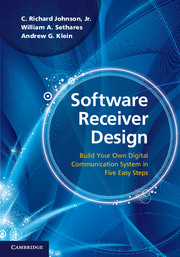Book contents
- Frontmatter
- To the Instructor …
- Contents
- Dedication
- Step 1 The Big Picture
- Step 2 The Basic Components
- Step 3 The Idealized System
- 4 Modeling Corruption
- 5 Analog (De)modulation
- 6 Sampling with Automatic Gain Control
- 7 Digital Filtering and the DFT
- 8 Bits to Symbols to Signals
- 9 Stuff Happens
- Step 4 The Adaptive Components
- Step 5 Putting It All Together
- Appendices
- Index
- References
7 - Digital Filtering and the DFT
from Step 3 - The Idealized System
Published online by Cambridge University Press: 05 June 2012
- Frontmatter
- To the Instructor …
- Contents
- Dedication
- Step 1 The Big Picture
- Step 2 The Basic Components
- Step 3 The Idealized System
- 4 Modeling Corruption
- 5 Analog (De)modulation
- 6 Sampling with Automatic Gain Control
- 7 Digital Filtering and the DFT
- 8 Bits to Symbols to Signals
- 9 Stuff Happens
- Step 4 The Adaptive Components
- Step 5 Putting It All Together
- Appendices
- Index
- References
Summary
Once the received signal is sampled, the real story of the digital receiver begins.
An analog bandpass filter at the front end of the receiver removes extraneous signals (for instance, it removes television-frequency signals from a radio receiver) but some portion of the signal from other FDM users may remain. While it would be conceptually possible to remove all but the desired user at the start, accurate retunable analog filters are complicated and expensive to implement. Digital filters, on the other hand, are easy to design, inexpensive (once the appropriate DSP hardware is present), and easy to retune. The job of cleaning up out-of-band interferences left over by the analog BPF can be left to the digital portion of the receiver.
Of course, there are many other uses for digital filters in the receiver, and this chapter focuses on how to “build” digital filters. The discussion begins by considering the digital impulse response and the related notion of discrete-time convolution. Conceptually, this closely parallels the discussion of linear systems in Chapter 4. The meaning of the DFT (discrete Fourier transform) closely parallels the meaning of the Fourier transform, and several examples encourage fluency in the spectral analysis of discrete data signals. The final section on practical filtering shows how to design digital filters with (more or less) any desired frequency response by using special Matlab commands.
Discrete Time and Discrete Frequency
The study of discrete-time (digital) signals and systems parallels that of continuous-time (analog) signals and systems.
- Type
- Chapter
- Information
- Software Receiver DesignBuild your Own Digital Communication System in Five Easy Steps, pp. 130 - 151Publisher: Cambridge University PressPrint publication year: 2011



